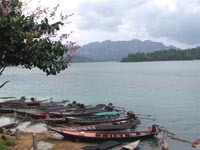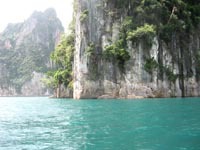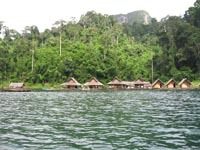Khao Sok National Park
There is very little pristine jungle remaining in Phuket. There is Khao Phra Thaew National Park but in the great geographic scale of things, it is not a big area. Most of Phuket's hills still have a good covering of forest but it is not really jungle. Phuket's great natural attractions are its beaches. It does not claim to be a nature or trekking retreat.
However, for those who really want to get into the wild, there is a huge area of jungle, rivers and lakes less than two hours drive from Sarasin Bridge. It is Khao Sok National Park. We decided to check it out.
Khao Sok National Park is in Surat Thani Province. It covers 740 sq km and when you include the neighbouring parks and wildlife sanctuaries, there is a huge 3,000 sq km area of wilderness. There are two main entrances to the park on route 401 between Takua Pa and Surat Thani. We went to the Ratchaprapa Dam entrance.
 The dam has created a huge lake that
covers a large area of the park. There is an office at the eastern end of
the dam. This is where you can hire a boat to explore the lake and if you
want to stay overnight, you can arrange basic accommodation within the park.
This is also where you will pay your park entrance fee - 200 baht for foreigners.
The dam has created a huge lake that
covers a large area of the park. There is an office at the eastern end of
the dam. This is where you can hire a boat to explore the lake and if you
want to stay overnight, you can arrange basic accommodation within the park.
This is also where you will pay your park entrance fee - 200 baht for foreigners.
We booked a night stay at one of the floating rafthouses on the lake and jumped into a longtail boat. The boat charge was 2000 baht. That was to take us to the rafthouse and collect us again the next day. The accommodation was 600 baht per person.
At first glance, the lake does not appear to be that big. It is not until you have been skimming across the water for 15 minutes that you realize this lake meanders between the great limestone karsts that you can see in the distance from the dam. These limestone karsts are the same impressive features that you will see at Phang Nga Bay or Phi Phi Islands, but they are far bigger. Some of them approach 1,000 meters high. They rise vertically from the green-blue waters of the lake and tower above your heads. Green foliage grows on every crevice and slope to which it can cling.
 As
we passed one limestone karst after another, we began to get an idea of the
scale of the area. I found myself wondering what we would do if the worst
happened and the boat sank. There really would be nowhere to go. You could
swim to the side but every side is a vertical rock covered in impenetrable
undergrowth. You really would not be able to go anywhere. You would just have
to find a ledge and wait for the next boat to pass.
As
we passed one limestone karst after another, we began to get an idea of the
scale of the area. I found myself wondering what we would do if the worst
happened and the boat sank. There really would be nowhere to go. You could
swim to the side but every side is a vertical rock covered in impenetrable
undergrowth. You really would not be able to go anywhere. You would just have
to find a ledge and wait for the next boat to pass.
The scenery is quite magnificent. As the dam disappears from sight, most signs of human intrusion are gone. There is only water and limestone karsts. We passed a couple of the floating rafthouses that the park provides for accommodation but clearly, they weren't ours.
 After
an hour traveling across the lake, the boat dropped us off at the base of
a jungle trail. We needed to walk. A one kilometer trek up a hill and then
down the very slippery other side brought us to the edge of another lake.
Then there was a short raft ride and we were at the 500 Rai Rafthouse.
After
an hour traveling across the lake, the boat dropped us off at the base of
a jungle trail. We needed to walk. A one kilometer trek up a hill and then
down the very slippery other side brought us to the edge of another lake.
Then there was a short raft ride and we were at the 500 Rai Rafthouse.
These rafthouses are basic accommodation. You are in the jungle so don't expect any comforts. They are a row of bamboo huts floating on the lake. Each hut is about three meters square with a mattress on the floor and a mosquito net. There is also a small restaurant. The electricity only comes at night and there is no telephone signal.
600-baht per person may sound expensive for such basic accommodation but I was soon convinced it was a great deal. A Thai family takes care of the rafthouse and guests. They make sure their guests get plenty of personal attention. The 600-baht not only includes dinner, breakfast and lunch but also free use of the kayaks. Great, I was soon on the water paddling around the lake. It wasn't long before I was swimming in the inviting green water.
After a couple of hours play in the water, our hosts called us back to the restaurant. Dinner was served. This was not a quickly knocked-up fried rice. It was a fine spread of tom kah gai, gaeng som, pad pak boong, Thai omelet and fried fish all served with as much rice as you could eat. The food kept coming until we were fully satisfied.
 The
lake is nestled between the limestone karsts, all covered in dense jungle.
As dusk settled, the lakeside fauna set the mood with a concerto of jungle
noise. The cicadas, tree frogs and assorted other fauna regaled us with their
music. Mosquito repellant is a good idea but there did not seem to be too
many around. It was time to sit back and enjoy a few beers. It is amazing
how you can see so many more stars and they are so much brighter, when you
are away from the lights of civilization.
The
lake is nestled between the limestone karsts, all covered in dense jungle.
As dusk settled, the lakeside fauna set the mood with a concerto of jungle
noise. The cicadas, tree frogs and assorted other fauna regaled us with their
music. Mosquito repellant is a good idea but there did not seem to be too
many around. It was time to sit back and enjoy a few beers. It is amazing
how you can see so many more stars and they are so much brighter, when you
are away from the lights of civilization.
In the morning, we were gently awoken by the jungle cacophony. Gibbons chattered in the trees across the lake. Breakfast was rice soup with a selection of dishes. The rafthouses also provide tea and coffee whenever you want. Then our hosts took us for a bit of fishing. We pulled a couple of healthy sized fish out of the lake that our hosts would fry later for lunch.
There was still plenty of time for more swimming and kayaking. The rafthouse offers a few local tours if you have the time and energy. You can do a boat trip into local caves or trek around some nature trails. They also offer a nighttime spotlight boat tour to look at the local wildlife (apparently, you don't see very much).
Lunch was another fine spread including the two fish we had caught earlier. There was time for a final kayak and swim before it was time to head home. If you really wanted to enjoy Khao Sok and chill out, you could easily spend several days or even a week exploring all the local natural attractions. You can also go trekking, rafting down the river or elephant riding.
The Ratchaprapa Dam entrance to Khao Sok National Park is 10 km from route
401. From Phuket, drive through Phang Nga and Thapput and then turn right
on to route 401, which runs between Takua Pa and Surat Thani. You soon come
to the small town of Bantakun. Here, there is a left hand turn towards the
dam.
